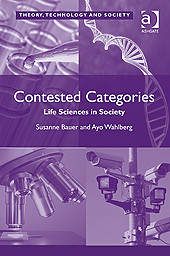Two years ago, in January 2007, our own Susanne Bauer co-organised a meeting titled ‘Contested Categories’ here at Medical Museion. Now, a proceedings volume with the same title, co-edited by Susanne and Ayo Wahlberg (formerly BIOS, LSE), has been published by Ashgate. From the back cover:
Contested Categories presents a series of empirical studies that engage with the often shifting and day-to-day realities of life sciences categories. In doing so, it shows how such categories remain contested and dynamic, and that the boundaries they create are subject to negotiation as well as re-configuration and re-stabilization processes.
Organized around the themes of biological substances and objects, personhood and the genomic body and the creation and dispersion of knowledge, each of the volume’s chapters reveals the elusive nature of fixity with regard to life science categories. With contributions from an international team of scholars, this book will be essential reading for anyone interested in the social, legal, policy and ethical implications of science and technology and the life sciences.
 Contents:
Contents:
Foreword, Gísli Pálsson
Introduction: categories of life, Ayo Wahlberg and Susanne Bauer
Human and object, subject and thing: the troublesome nature of human biological material (HBM), Cecily Palmer
Substances of the body: blood, genes, and personhood, Malin Noem Ravn
Governing risk through informed choice: prenatal testing in welfarist maternity care, Mianna Meskus
Visualising and calculating life: matters of fact in the context of prenatal risk assessment, Nete Schwennesen and Lene Koch
Serious disease as kinds of living, Ayo Wahlberg
From society to molecule and back: the contested scale of public health science, Susanne Bauer
Life beyond information: contesting life and the body in history and molecular biology, Adam Bencard
The place and space of research work: studying control in a bioscience laboratory, Amrita Mishra
Almost human: scientific and popular strategies for making sense of ”missing links”, Murray Goulden and Andrew S. Balmer
Nikolas Rose and Margaret Lock have written the blurbs:
‘The vital landmarks that humans use to negotiate their existence as living beings are under challenge by bioscientific knowledge and biomedical technique, and an unstable mixture of venture capital and human desire. What is alive? Who is normal? When is sadness a disease? What is natural and what is artifice? Where does my body end and my prosthetics begin? Who can own what when it comes to human bodies? – These questions are not merely philosophically profound but they shape the ways in which human life is managed today. This stimulating collection brings together the reflections of a new generation of scholars, and clearly demonstrates the crucial role that empirical investigation can play in helping us grasp the challenges posed by this widespread contest of the categories we live by.’ (Rose)
‘This path-breaking collection takes the social analysis of emerging practices in the life sciences in an important new direction. Focusing on the labeling and classification of biomedical objects and entities, contributors to this volume make abundantly evident the extent to which the significance and meanings attributed to such entities are transformed and reworked as they travel among laboratory scientists, clinicians, policy makers, and the public. Classificatory practices are never merely “technical” in kind, but exhibit a social life of their own. This book draws readers into a world of boundary making in the life sciences that demands a generous pause for considered reflection.’ (Lock)


